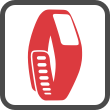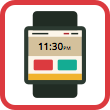In the last five years, there has been a shift away from periodic health check-ups to continuous health monitoring, personalized medicine, and preventive care. As a result of this shift, a wearable technology revolution has come into existence. Delivering primary, preventive, and personalized care, the new generation wearables are like extensions to human body. Once you put on an innovative wearable, you automatically worry less about your health and consequently live more.
Smart watches that can track your steps and monitor your run; contact lenses that are built to measure glucose levels in tears; wearable patches that can detect all sorts of environmental hazards, like UV radiation and toxic gases; an air bag that can be worn on your wrist to save you from drowning. Sound like the next episode of Ripley’s Believe It or Not!
Although the examples of wearable technology cited above might seem to be straight out of science fiction, they are not just gimmicks: while a few wearable technologies, like smart watches and bands, are already available in the market, others are being created as you read this article. Who knows by the time you have finished reading this article, a scientist creates buttons for your shirt that inform you days in advance of an approaching sickness. Designed to monitor your health 24/7, wearable technology can act as your guardian angel and save your life.
First Generation
 Smart Bands and Trackers:
Smart Bands and Trackers:
Wearable technology first became trendy when fitness bands and trackers took the world by storm. Fitbit Charge HR, Jawbone UP2, Moov Now, Vivoactive, and Xiaomi’s Mi Band are some of the popular wearable bands available in the market. These bands and trackers are comfortable, durable, and water resistant. More importantly, they perform a range of functions such as continuous monitoring of heart rate, recording calorie count, and tracking quality of sleep.
What’s more, these bands and trackers pair well with smartphones. Fitbit, for instance, offers an app wherein a person can log food activities, weight, blood pressure, heart rate, and glucose levels to track over time. Competing apps such as “Runtastic” offer consumers a variety of home workout programs that can help them maintain their health.
Second Generation
 Smartwatches for Serious Diseases:
Smartwatches for Serious Diseases:
The latest wearable technology that has become a household name is a smartwatch. But did you know that the Michael J. Fox Foundation is now collaborating with Intel to use smartwatches for treating sufferers of Parkinson’s disease? The new smartwatches gather data to track the progression of Parkinson’s disease and assess how well a patient is responding to medication. By recording patients’ tremors, gait, and sleeping habits, these watches are generating significant insights into a little understood disease.
 Wearable Airbag on your Wrist:
Wearable Airbag on your Wrist:
Besides a smartwatch, there is another device that you can wear on your wrist, which can potentially save your life. “Kingii”, a wrist-worn airbag, is the smallest inflatable device that impedes drowning. The device basically consists of a nylon bladder and an over-sized CO2 canister. Pulling a lever inflates the folded orange bladder in a matter of seconds and helps the wearer to stay afloat. In case, you are in a stormy sea, the device comes with a whistle and a button compass, which can help you to return to the shore.
 Stretchy Patches for Cancer Prevention:
Stretchy Patches for Cancer Prevention:
Engineers at the RMIT University in Australia are working on patches that can detect environmental hazards, like UV radiation, and potentially prevent skin cancer. In addition, these patches can detect toxic gases, which are often responsible for lung cancer, asthma attacks, and other respiratory problems. Stretchy, sensitive, and transparent, these patches stick to the skin or can be sewn into clothing. When the sun is too hot or pollution is too high, the sensors in the patches send information to smartphones and alert wearers to potential environmental hazards.
Foot Friendly Technology:
Technology:
French company “Digitsole” has come up with a new heated insole that can be controlled by an app and alleviate the suffering of people with poor circulation in their feet. Additionally, these insoles are capable of tracking steps and calories so that the wearer remains fit and light-footed.
Next Generation
Glimpse into Future Wearables with Google Glasses and Lenses:
Through its award winning smart glasses and cutting-edge contact lenses, Google, now Alphabet, has positioned itself at the forefront of the wearable tech revolution. Google’s approach to wearables, according to research scientist Dr Xize Niu, is different from its peers:
“when people talk about wearable healthcare devices at the moment, they think about monitoring the user’s heart rate, blood pressure, and all these kinds of physical things. What we’re developing is a wearable [device] that can continuously monitor the chemicals in people’s bodies.”
As early as 2013, Google disrupted healthcare technology by releasing a prototype of the Google Glass. The internet-connected Google glass is essentially a wearable computer with a built-in camera and monitor. Surgeons at Duke and several other hospitals are already using this glass to stream and record surgeries, to float medical images in their field of view, and to hold consultations with other surgeons while operating on patients.
Smart glasses are now paving way to smart contact lenses. Working in collaboration with Novartis, Google is developing contact lenses that will help diabetics monitor bodily functions, such as blood glucose levels, via minuscule sensors. Diabetes, which affects 1 in 19 people on the planet, is known to result in serious complications involving damage to eyes, kidneys, and heart. To put it briefly, through an innovative wearable, Google is targeting eye care technology, cure for diabetes, and prevention of serious complications simultaneously.
Finally, consumers of wearables can rejoice in the fact that medical care is becoming preventive and accessible. Health care providers can take pleasure in the prediction that revenues from smart wearable devices will hit $19 billion by 2018. Stop worrying and let companies vie for your medical data because better health is just around the corner.









